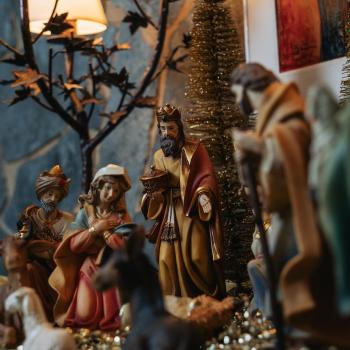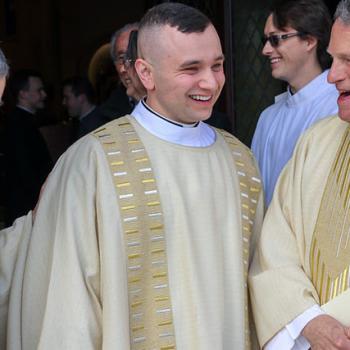These tall pillar-like lamp-stands were probably meant to symbolically evoke the pillar of fire that guided Israel in the wilderness, and rested before the temple at its dedication. This "pillar of fire" was the visual manifestation of the presence of God with Israel. It first appeared to guide the Israelites on their flight from Egypt (Ex. 13:21, 14:24) and on Mount Sinai (Ex. 19:18). It continued to guide Israel through the wilderness (Num. 14:14; Neh. 9:12, 19), resting on the tabernacle as the visible manifestation of the presence of God (Ex. 40:38; Num. 9:15-16), and finally in the temple when dedicated by Solomon (1 Kgs. 8:11; 2 Chr. 7:1-3).
Thus, in the first-century context of the flaming lamp-stands at the temple and the Sukkot traditions commemorating Israel's wilderness wanderings, Jesus' proclamation that he was the "light of the world" was intended not merely as a spiritual metaphor, but as a proclamation that he was God, the true light of the world, who had manifest himself anciently as the pillar of fire at the temple.
The Light of God shining upon Israel and the nations is also an important messianic theme in Jewish scripture (Is. 9:2, 42:6-7, 49:6, 60:1-5; Mal. 4.2). Jesus, the messianic light of God, shines forth in the temple, and will eventually become a light unto all the nations. John's gospel also evokes a fundamental dualism between light and darkness that is also found elsewhere in first-century Jewish thought. This theme is especially prominent in the Dead Sea Scrolls, which describe a cosmic struggle between the Sons of Light and Sons of Darkness. Jesus as the light of the world is a constant refrain in John's gospel.
- The Light shines in the darkness (1:1-5).
- The Light enlightens mankind (1:6-9).
- The Light struggles with darkness (3:19-21).
- Jesus is the Light of the world (8:12, 9:5).
- Those who accept Jesus walk in the light (11:9-10, 12:46).
- Those who follow the Light become the "sons of light" (12:35-36).
The earlier nutrition metaphors of Jesus that I've already discussed point to Jesus as the foundation of life: breath/spirit, water, bread and blood. Here the emphasis is shifted to the life of the mind and soul. Light is a life-giving substance to the soul, enlightenment (1:9), which allows the enlightened soul to properly perceive God, the Messiah, and the true nature of the kosmos/world. Only those enlightened by God can walk in the light, and thereby know, believe, and live the truth. In later discourses, Jesus will explain the nature of the transformation of those who accept the Light.
When Jesus says he is the Light of the world, he is alluding to a very specific cosmic context. John's concept of the world/kosmos has been discussed in my exploration of John 3:16-19. There I summarized the concept of kosmos -- the world of human beings—as follows:
The inhabitants of the kosmos are thus characterized by ignorance, rejection of the spirit of truth, lovers of darkness, workers of evil, and haters of Jesus and his disciples. The ruler of the kosmos is Satan, who has been engaged since Eden in an ongoing cosmic struggle with the Father and the Son for control both of the inhabitants of the kosmos, and the kosmos itself. The Logos/Word has come down from heaven to "cast out" (Jn. 12:31) Satan from the kosmos and bring those who will accept Jesus as the Messiah—thereby accepting his grace, truth, love, and knowledge—back into the light, the presence of the Father, and the unity and love of the Father and Son (Jn. 17). Thus, when the kosmos does not know the Light (1:10), it means that the inhabitants of Satan's world order do not recognize Jesus as the Messiah.
The Light thus not merely enlightens individuals, but radically transforms the nature of the very kosmos itself. The entire kosmos is enlightened by the presence of the Messiah, and the powers of Darkness are dispelled and cast out.
Bearing Witness of Yourself (8:13-19).
In this section the Pharisees engage in a dispute with Jesus over his alleged self-testimony. I have discussed this issue in my exploration of John 5:30-38, where Jesus describes three witnesses that he is the Messiah.
Here in chapter 8 the Pharisees are condemning Jesus for bearing witness of himself (8:13, 5:31). Jesus' response is that the Pharisees are judging according to the flesh (8:15), and therefore misunderstand spiritual realities. Jesus also says that the Father testifies of Jesus, whose testimony the Pharisees don't accept because "You know neither me nor my Father. If you knew me [as the Messiah], you would know my Father also" (8:19).





